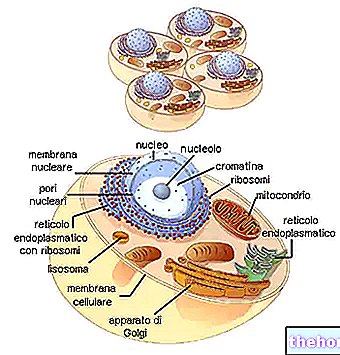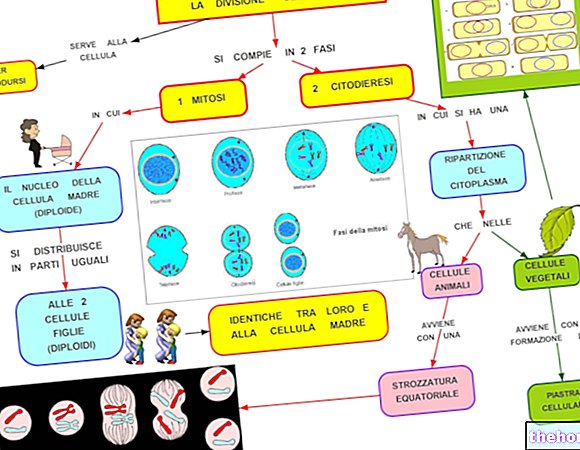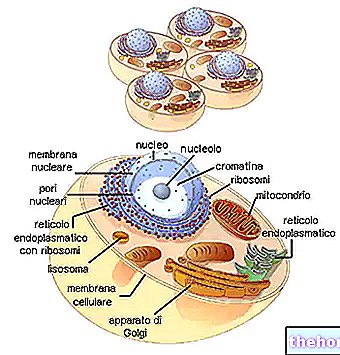We have seen that in sexual reproduction there are male and female gametes. These are produced by organisms that are male or female respectively. But how is sex determined? In general, the determination of sex is genotypic, that is, it depends on the chromosomal set. Equally in general, the phenotypic sex corresponds to the genotypic sex. In both cases, however, there may be exceptions. Genetic (or chromosomal) sex is determined by the genome. In each species there is a characteristic number of chromosomes (karyotype) of which only some are in charge of determining the sex (the gonosomes) while the others are called autosomes. The gonosomes in the normal diploid genome are at most two: one per haploid set, that is, one per gamete.
In humans, the 46 chromosomes of the diploid set include two series of autosomes (22 + 22 = 44) and two gonosomes. In other species the ratios are variable.
The female has two X gonosomes and the male one X and one Y.
Female gametes will always receive an X, while spermatozoa are equally likely to carry an X or a Y: in the former
case they will give XX zygotes (females), in the second zygotes XY (males). We therefore speak of female homogamety and male heterogametry, since only in the male the gametes are not all the same.
The sex determination of the new organism takes place at the moment of fertilization (singamic sex determination). In other species, however, different phenomena may occur.
PHENOTYPICAL SEX
Generally, but not always, phenotypic sex matches genotypic sex. There are species in which the phenotypic sex is determined by the environment (in the well-known Bonellia viridis the embryos that implant on the maternal organism become males, those that implant on the bottom become females: we then speak of metagamic determination of sex). In other species the individual can behave first as a female and then as a male: the phenotypic sex varies with age.
Phenotypic sex derives, in general, from the "action of hormones. Even in men, an alteration in the normal level of masculinizing or feminizing hormones (due to disease, malformation or external administration)" can determine phenotypic sexual characteristics that differ from genotypic sex. .
NUCLEAR SEX. BODIES OF BARR. MARY LYON'S THEORY
In the female, the observation under the microscope of cells treated with nuclear dyes reveals the presence of a mass of chromatin attached to the nuclear membrane, which is missing in the male cells, called Barr's body, after the name of the discoverer. the "Mary Lyon theory", according to which a cell contains only one X chromosome in metabolic activity; any excess X chromosome is "inactivated" and remains spiralized even during intercinesis, and therefore can be observed under the microscope.
This is confirmed by individuals with karyotype 47 [XXY (Klinefelter syndrome: abnormal and sterile male phenotype)], who have Barr's body while appearing male.
The determination of the nuclear sex can therefore be used in different cases: it can reveal a Turner syndrome (45; X0, female phenotype, Barr-negative) or Klinefelter; it can indicate the genotypic sex in case of indeterminate phenotype (to address any hormonal treatment in the same sense); it can reveal a male individual who disguises himself as a woman to win athletic competitions in the female categories; etc.
SEX-RELATED CHARACTERS
In some species, sex determination is linked to the relationship between autosomes and gonosomes, which shows that autosomes also help determine sex. The same can be said in the opposite sense: gonosomes also contain genes that determine non-sexual characteristics.
In the case of man this is especially true for the X chromosome and the characters whose locus is found on that chromosome. In fact, a recessive character carried by a heterozygous female does not manifest itself, but, if it is transmitted to a male child, it manifests itself. This happens because in the male the X chromosome is devoid, at least in most of its length, of a homologue that "covers" the mutations. In these conditions we speak of a hemizygous character, which evidently manifests itself in the phenotype. of such a recessive trait in the population is low, the case of a homozygous female will be very rare. Then the trait will be manifested only in 50% of the male children of the heterozygous carriers, who will never pass it on to their sons, while the daughters, generally heterozygous , they will not manifest it. Classical examples of such traits are haemophilia (which only affected males of the imperial family of the Habsburgs), as well as color blindness normally known like color blindness.









.jpg)


















